Capital:
Muscate
Currency
Riyal
Best time to visit:
The best time to travel to Oman is from November to mid-March, when the average daytime temperatures are 25 ° C. During the rest of the year, the heat is fierce in almost the whole country. The monsoon hits southern Oman between mid-June and mid-August. From mid-September the rains disappear and with them most of the vegetation.
In a word:
Tasharrafna (nice to meet you)
Vaccines
None
Warnings:
- Life slows down during Ramadan: several shops temporarily close their doors.
- In the desert you have to be careful of scorpions and snakes while in the sea there can be stingrays, jellyfish and dangerous snakes.
- Don't underestimate the heat factor and sunburn.
At the table:
Omani cuisine includes many dishes based on cardamom and saffron. Indian cuisine is also very popular (especially the tandoori and biryani dishes). There are also regional specialties such as meat skewers, mezze and falafel. Everyone likes dates and tropical fruit. As soon as you get the chance, try camel milk, rose water milk or warm ginger milk.


Essential experiences:
Lose yourself in Muscat's Old Town, with its limestone-clad houses and mosques in the shadow of Al-Mirani and Al-Jalali Fortresses; Turn aimlessly into the souq of utrah where the air is impregnated with the scents of incense and spices and the atmosphere is particularly animated in the evening; Do not miss the wadis (valleys) in the mountains with natural pools carved into the rock where you can take a bath
Oman, the sentinel of the Gulf, is located at the center of sea and land routes along one of the oldest trade routes in the world. Today the trade in myrrh and frankincense has been replaced by the production of gas and oil which guarantees a certain degree of well-being to the population.
Imagine a country where time seems to have stopped among the mud villages, where the deserts will captivate you with their magic, the landscapes will thrill you with their beauty, from the rugged mountains with deep canyons to the deserted beaches of the coast, the traditional markets , the wadis that with the rains fill with water at the edges of which there are palm groves and villages; forts, castles, cities with surrounding walls and watchtowers, a town where the inhabitants preserve a culture that still lives on today in traditions and customs. Here you are in the Sultanate of Oman: a casket of landscape and naturalistic treasures where the most demanding traveler can still experience the thrill of discovery.
Absolute monarchy, Oman was ruled by the far-sighted Sultan Qaboos Bin Said who, since 1970, has transformed the country by bringing it out of the deep state of backwardness in which it found itself, but being careful to preserve the traditions of his people who seem to be genuinely fond of him. . On his death, after 50 years of reign, he was succeeded by his cousin Haytham bin Tariq Al Sa'id.
I do not deny that we struggled to find a means of transport that would allow us to explore this land on an adventure. In the end, with the help of Faisal, a local friend of ours, we rented his car and drove aimlessly through wadis, traditional villages and breathtaking landscapes.
Our suggested itinerary (13 days) | |
four days: | Muscate (visit Sultan Qaboos Grand Mosque, Al Alam Palace, Mutrah souq) |
three days: | Hawyat Najem, Wadi Shab, Wadi Tiwi, Wadi Bani Khalid, Sur, Bidya (desert) |
two days: | Nizwa (visit to the Fort), Salalah |
two days: | Muscate (visit to the city's museums) |
The city of Muscat is one of the oldest in the Arabian peninsula, archaeological remains document the existence of a fishing village as early as the fifth millennium BC. In fact, since ancient times its port has played an important role in trade as a bridge between Africa and Asia.
It is characterized by a real mix of tradition and modernity, an aspect that makes it a very fascinating destination to visit.
The attractions to see in Muscate are many: starting from the most modern area of the city we find the Sultan Qaboos Grand Mosque. It is the third largest mosque in the world and the most important building of worship in Oman.
It is the most important place of worship in Oman, as well as a splendid example of modern Arab architecture. Made with 300,000 tons of Indian sandstone and excellent materials from various parts of the world, including Carrara marble (in the men's prayer room). It consists of 5 minarets representing the 5 pillars of Islam. It can host up to 20,000 faithful at the same time.
In the prayer hall there is the largest Persian carpet in the world with a single span 4,200 square meters of surface. At the center of the dome is a majestic chandelier over 14 meters long made of Swarovski crystal, the sight of which can only leave you breathless. The Sultan Qaboos Grand Mosque is open to visitors from 8:30 to 11:00 in the morning, every day except Friday, the day dedicated to prayer in Islamic culture. For access to the important place of worship, the choice of sober and opaque clothing is required, especially for women they must have covered head, long sleeves and skirts and trousers that cover the ankles.
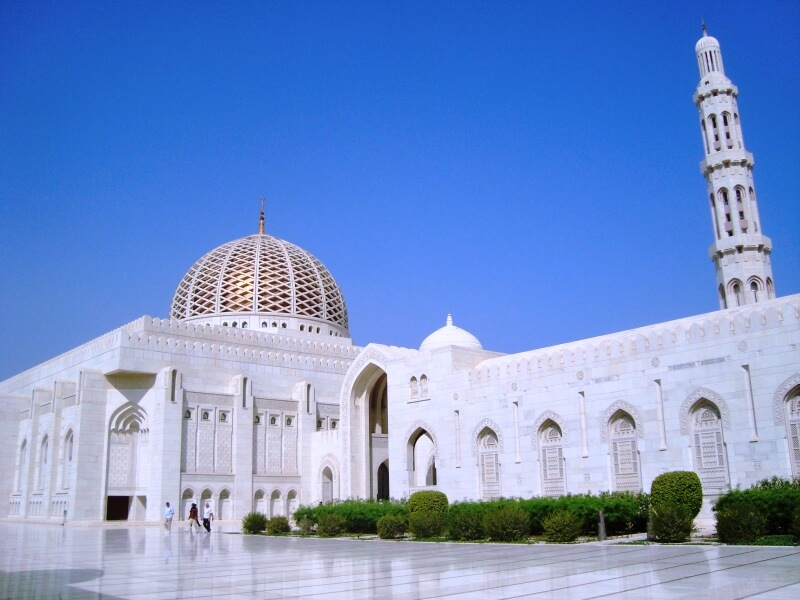
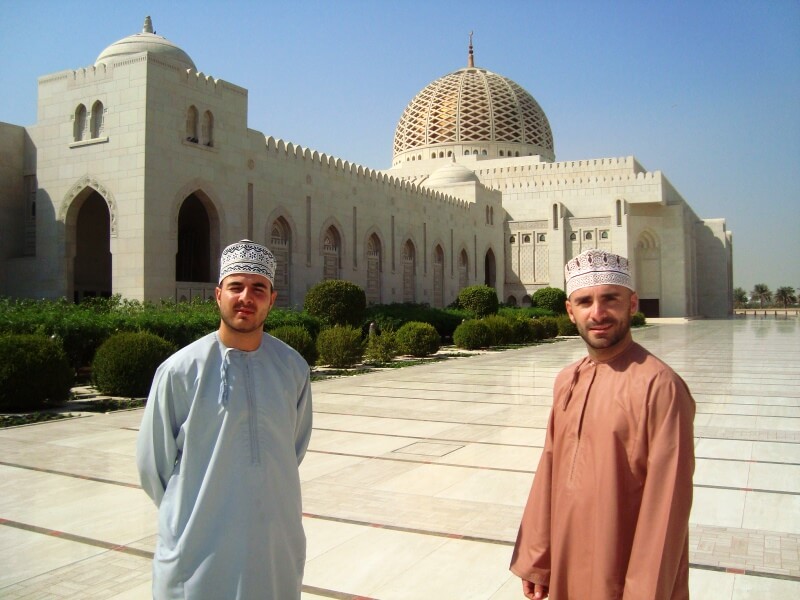
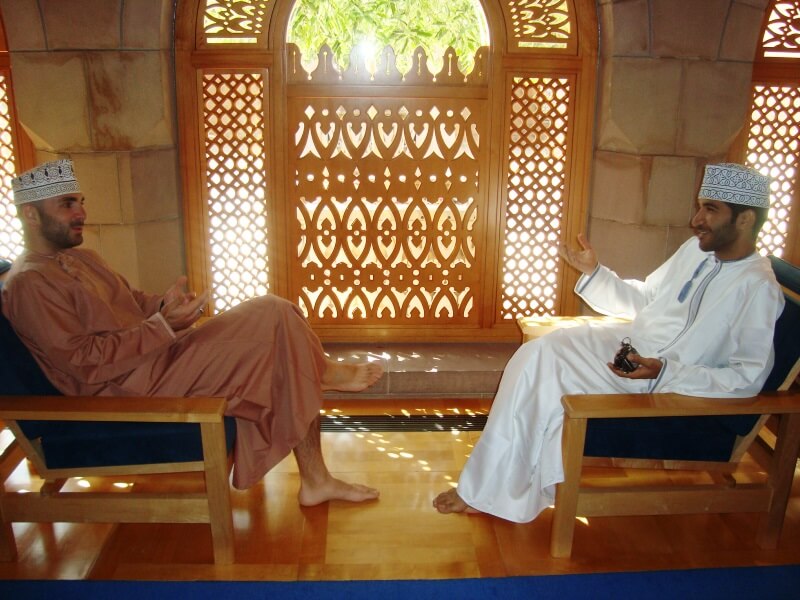


Continuing with the itinerary we find Palazzo Al Alam, the ceremonial residence of the Sultan, where the most prestigious guests visiting the country are received. The building is located in the heart of the old city and is also characterized by facades covered with luxurious white marble slabs.
The driveway is surrounded by wonderful columns decorated in gold and blue, with truly beautiful arches and carvings.
Near the Palace, you can visit: the National Museum of the Sultanate of Oman. The museum houses fourteen permanent galleries organized in chronological and thematic order and is responsible for preserving the historical heritage and promoting the traditional values of Oman.
Moving to the port area, two ancient defensive fortresses stand out: the forts of Al Jalali and Al-Mirani. Both perched on high cliffs, they offer breathtaking views of the crystal clear waters of the Gulf of Oman.
A must is a walk along the seafront, the Corniche, to get to the port of Mutrah, characterized by the famous fish market and the large souq. In fact, it will be exciting to enter the shops that for centuries have been the scene of negotiations between incense merchants from all over Asia.
It consists of squares and alleys where everyone calls you to show you their goods; the smell that fills the souq is of incense ...
We stop to eat two "shwarma" with the usual freshly squeezed orange juice along the Corniche ...

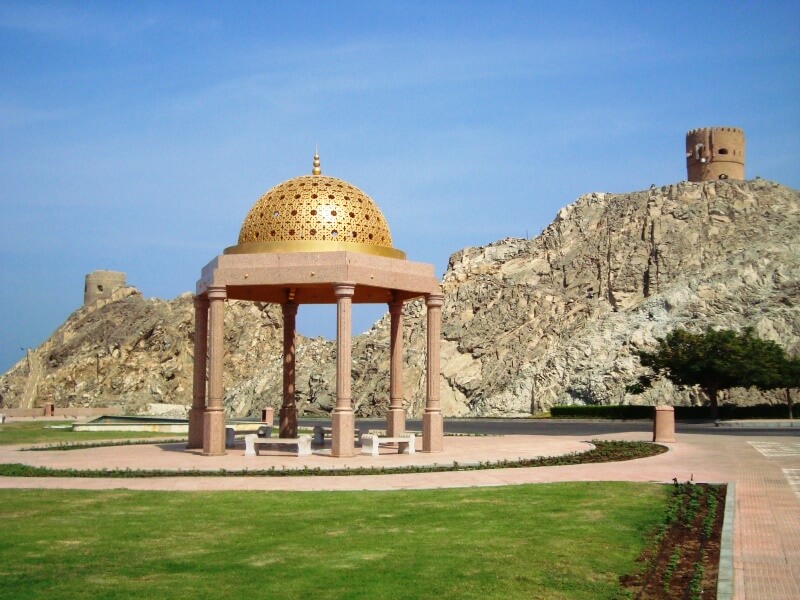








Today with the legendary Faisal and, after wearing "dishdasha" and "kuma", we take a stroll in various shopping centers immersing ourselves in the Arab atmosphere as never before while our friend told us about weddings in Oman ...
"How does it work when you want to get married?" Well, in that case, as happened to him, the sisters or the mother are unleashed and subject you to the vision of many photos of potential suitors ... so you can choose ... from his words it would almost seem that the woman has little say in the matter. Mah!
Today we set off to discover Oman, a do-it-yourself adventure by car with Faisal
The first stop is at Hawyat Najem, a 200-meter hole in the ground that seems to have been formed by the impact of a meteorite. Here the fresh water mixes with the sea water giving it a wonderful color.
Second stop is at Wadi Shab.
The wadis represent one of the most characteristic elements of the Omani territory: these rivers give rise to small oases that interrupt the desert landscape. Often hidden among the rocks of natural canyons, the waters of incredible blue-emerald tones give life to lush vegetation and attract dromedaries and birds, creating real corners of earthly paradise.
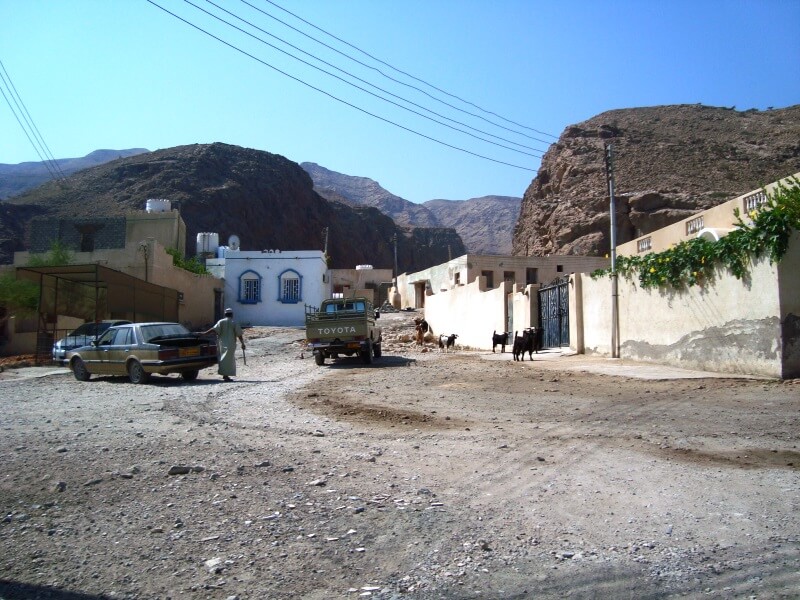




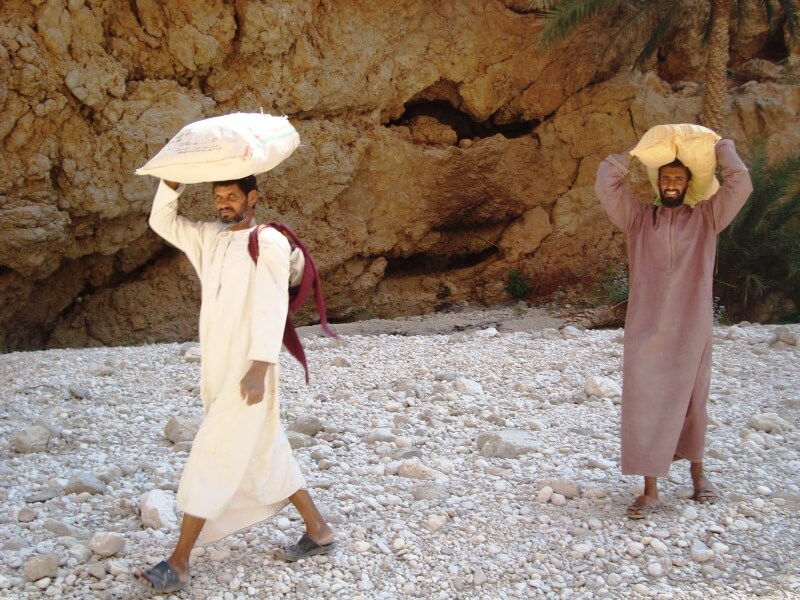



Continuing, here we are in Wadi Tiwi, from the coast before arriving in Sur you turn inland to get to this lovely oasis whose waters emerge among the rocks, surrounded by the walls of a narrow canyon. Filled with fruit trees and palm trees, it offers a relaxing landscape.
From here, a three-day trek will take you to Wadi Bani Khalid.
Wadi Bani Khalid, this beautiful location is home to natural lakes nestled between the rocks. The emerald waters create a wonderful contrast with the white stone walls and visitors are allowed to bathe with special precautions.
We head to Sur, a fishing village where we visit an artisan factory of dhows (typical boats) totally assembled by hand, from cutting logs to bolting etc.
Mass tourism really does not exist here, we never met a souvenir seller all the way ...
Here, it will be possible to visit the traditional shipyards as well as the interesting maritime museum that tells the ancient story of the great Omani navigators.
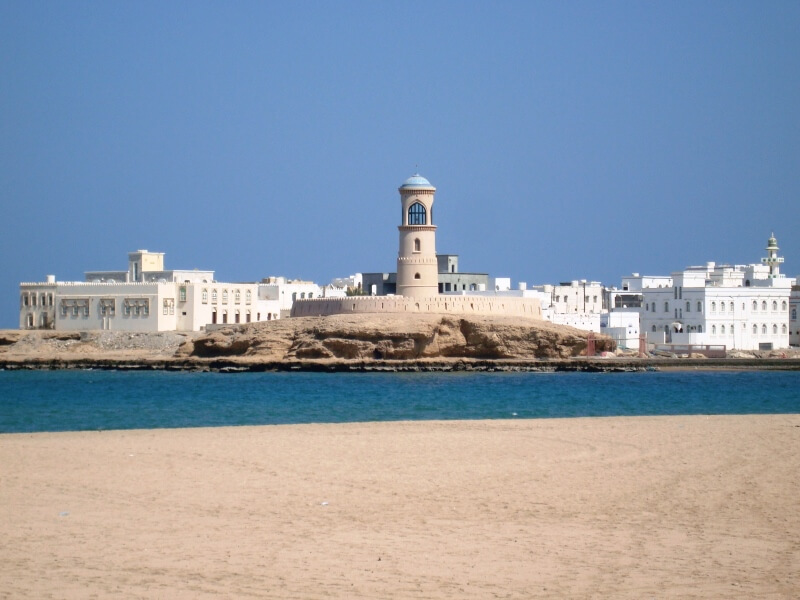
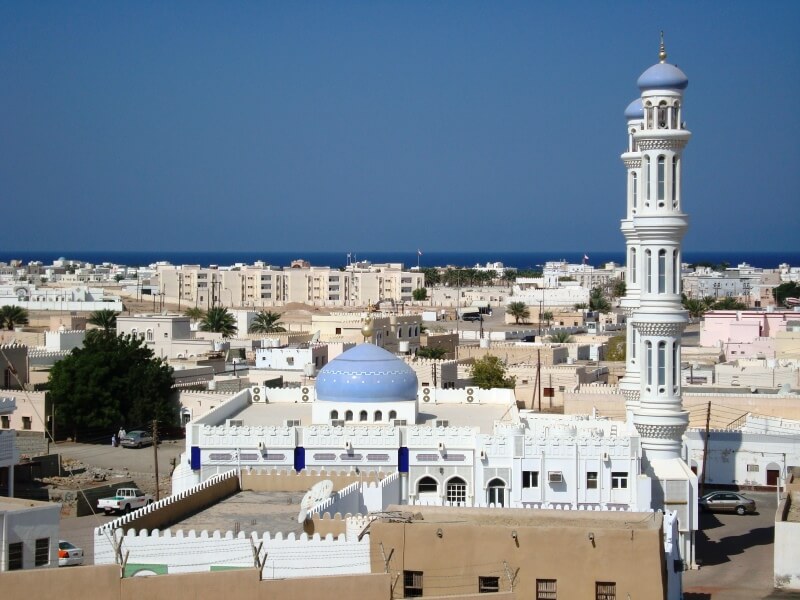







It is almost sunset. We try to quickly reach Bidiya and its Wahiba Sands desert with its fine red sand ...
The sun sets ... Silence broken only by the cries of the dromedaries around us and by a plastic bag carried by the wind ... The light of the half moon that lit us dimly and our thoughts ...
Two hours from Muscat, we find the fortified city of Nizwa. Built in the center of the mountainous region, it serves as an access point to the desert areas.
It is the ancient capital of the kingdom and still occupies a prominent place in commerce today. Its souq is one of the most beautiful in the country, famous for the sale of dates and the production of silver. Nizwa is the best place to buy original and typical souvenirs.
Here you can buy an old Khanjar at a good price, the richly decorated curved dagger that men proudly display during traditional ceremonies.
Don't miss the Friday Livestock Market, during which, from dawn to 9 am, Bedouins from different tribes participate to sell and buy, especially dromedaries and goats from farmers living in the surrounding mountains. Finally, it is worth visiting the famous fort that has watched over the entire city for centuries.





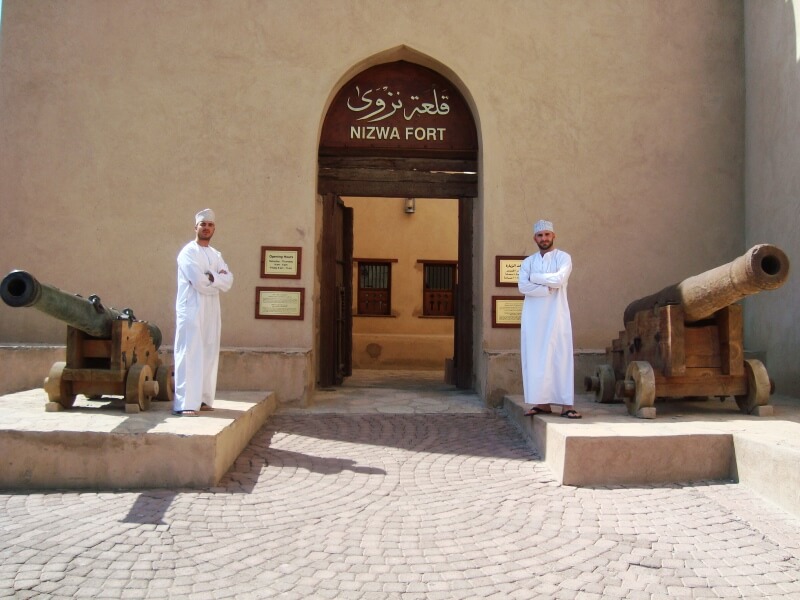




The last stop is the Hoota Cave, a cave discovered by chance a few years ago ...
An interesting visit but even more characteristic was the typical lunch seated in a room with carpets and pillows: a plate of rice, chicken, camel meat and all off to eat with their hands from the same dish ...
Continuing south along the pristine coast, we arrive at Salalah, the last outpost before mysterious Yemen. Capital of the Dhofar region, for centuries it has been the hub of the incense trade and a must for traders who went to the court of the Queen of Sheba.
However, the flagship are the pristine white sand beaches wedged between the headlands that housed the lookout towers for boats.
Avoid Dhofar in the months from June to mid-September, when the region is hit by the Kharif, the monsoon that brings winds and rains throughout the area.
We go back to the capital!
Cultural day dedicated to visiting the two museums of the capital.
French-Omani Museum. A museum dedicated to the visit of the old French President Mitterand to the Sultanate, which was later reciprocated by the beloved Sultan Qaboos in Paris. An entire museum dedicated only to this event.
More interesting, however, was the "Bait Al Zubair" which tells a bit of the history of this unknown country.





I will not easily forget the courtesy, hospitality, good manners, education, generosity of all Omani people!
Oman: where shopkeepers leave the goods to be sold outside their shop even after closing "so nobody touches anything!" The place where the taxi driver, after you have paid and are about to leave, calls you back because you left your cell phone in his car; the place where the restaurateur calls you back because you paid with a 5 Riyal banknote instead of 1 and you are about to leave ... The place where there are those who offer you a drink, those who show up giving you the "welcome" instead of saying your name ... This is Oman that I will always carry in my heart.
We had the opportunity to release an interview for the Oman Daily Observer entitled "Two Gypsy Souls" inObserver Weekend.
The Oman Daily Observer is a national English-language newspaper of the Sultanate of Oman.
We talked a little about the experience of traveling to the land of Sultan Qaboos as well as our adventures around the world! (interview in English only)
Error: No feed found.
Please go to the Instagram Feed settings page to create a feed.
2 Responses
Would You pls tell me when you come to our Beautiful Bangladesh?
I will with great pleasure
Thank you very much